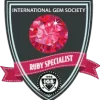

A synthetic gem material is one that is made in a laboratory, but which shares virtually all chemical, optical, and physical characteristics of its natural mineral counterpart, though in some cases, namely synthetic turquoise and synthetic opal, additional compounds can be present.
The first commercially successful synthetic gems were created by the flame fusion process. This process involves dropping powdered chemicals through a high-temperature flame, where it melts and falls onto a rotating pedestal to produce a synthetic crystal. Today it remains the least expensive and most common way to make gems such as synthetic corundum and spinel.
Pulling emerged in the early 1900s. In this process, nutrients are melted in a crucible and the synthetic crystal grows from a seed that is dipped into the melt, and then slowly pulled away from the melt as it grows. Gems synthesized by pulling include synthetic alexandrite, chrysoberyl, corundum, and garnet.
Today some synthetic gems, such as emerald, ruby, sapphire, alexandrite, and spinel can be created through a flux-growth process. Flux is a solid material that, when melted, dissolves other materials in the same way that water dissolves sugar. As the dissolved chemical solution gradually cools, synthetic crystals form.
Growing a synthetic gem by the flux method requires patience and significant investment. Crystal growth can take up to a year, and the equipment is very expensive. But the results, especially when it comes to emerald, are well worth the time and effort.
Like the flux process, the hydrothermal growth process is slow and expensive. But it’s the only method for successfully growing synthetic quartz. This process requires heat and pressure and imitates the conditions deep in the earth that result in the formation of natural gems. Nutrients are dissolved in a water solution, and then synthetic crystals form as the solution cools.
Retrieved from: https://www.gia.edu/gem-synthetic





